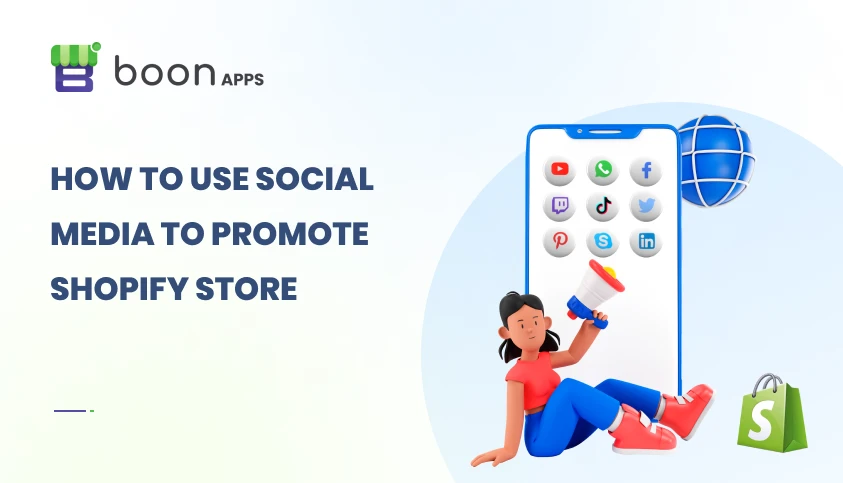In today’s digital landscape, social media has become an indispensable tool for businesses, especially for e-commerce platforms like Shopify. With billions of users actively engaging on various social media channels, these platforms offer unparalleled opportunities for brands to connect with their target audience, drive traffic, and boost sales. In fact, studies show that nearly 54% of social media users browse the platforms to research products before making a purchase, highlighting the importance of a robust social media presence for any online store.
Promoting your Shopify store through social media not only enhances visibility but also fosters community engagement and brand loyalty. In this guide, we’ll explore strategic approaches to harness the power of social media for your Shopify store.
From setting up your profiles to crafting engaging content and utilizing targeted advertising, you’ll learn how to create a cohesive social media strategy that not only attracts followers but also converts them into loyal customers. Learn how to effectively leverage social media to boost your Shopify store’s visibility and sales with the best Shopify mobile app builder tools and strategies. Let’s dive into the dynamic world of social media marketing and discover how it can elevate your Shopify store to new heights!
Understanding Your Target Audience
Identifying Your Ideal Customer
To successfully market your products or services, it’s essential to know exactly who your ideal customer is. Identifying your target audience involves understanding key demographic factors such as age, gender, location, income level, and education. These characteristics allow you to create a more tailored and effective marketing strategy.
Beyond demographics, it’s equally important to understand your audience’s interests, values, and behaviors. The more specific you can get about your target audience, the more focused your marketing efforts will be, leading to higher conversion rates and better overall engagement.
Analyzing Audience Behavior on Social Media
Social media platforms offer a wealth of data on user behavior, which you can leverage to better understand your audience. Tools like Google Analytics, Facebook Insights, Instagram Insights, and third-party tools such as Hootsuite or Sprout Social allow you to monitor trends in user engagement, track the performance of your posts, and discover which content types (videos, images, or text) are most appealing to your audience.
By understanding these behaviors, you can optimize your social media strategy, ensuring that your content aligns with audience expectations and maximizes engagement. Tracking metrics like reach, impressions, clicks, and conversion rates across different social platforms will help you adapt your approach to each audience segment and make data-driven decisions to improve overall campaign success.
Read more: Boost Your Sales: How to Promote Your Shopify Store Effectively
Choosing the Right Social Media Platforms
Overview of Popular Social Media Platforms
When promoting your Shopify store, it’s essential to understand the strengths of different social media platforms. Each platform offers unique features and audiences, making them suited for different marketing strategies. Here’s a quick overview of the most popular social media platforms and how they can help your Shopify store grow:
1. Instagram

Instagram is a highly visual platform, making it ideal for businesses with product-focused content. With features like Stories, Reels, and Instagram Shopping, brands can showcase their products through images and videos while allowing customers to purchase directly from the app.
2. Facebook
Facebook remains one of the largest social networks with a diverse user base. Its advanced targeting tools for ads and Facebook Marketplace make it a powerful platform for driving sales. Brands can also use Facebook Shops, groups, and live streaming to connect with their audience and boost engagement.
3. TikTok
TikTok is a fast-growing platform known for short, creative videos, making it perfect for engaging younger audiences. Viral trends and user-generated content can drive significant traffic to your Shopify store, especially if you create shareable and fun content or collaborate with influencers on the platform.
4. Pinterest
Pinterest is a visual discovery platform where users search for inspiration. With Pinterest’s “Shop the Look” and “Buyable Pins” features, you can directly link your products, making it easy for users to buy from your Shopify store.
5. Twitter
Twitter is a real-time platform where short updates, promotions, and conversations thrive. It’s useful for building brand awareness, sharing news, and engaging in direct conversations with customers. Regular interaction with followers, trending hashtags, and Twitter ads can help boost visibility for your store.
6. LinkedIn
While LinkedIn is primarily a professional networking platform, it can be valuable for B2B Shopify stores. Businesses can promote thought leadership, share content about industry trends, and network with potential partners or corporate buyers.
Understanding these platforms key strengths and audiences will help you decide where to focus your efforts and how to tailor your content to maximize engagement and sales for your Shopify store.
Selecting Platforms Based on Your Niche
Choosing the right social media platform is crucial for targeting the right audience. If your niche is visually focused, like fashion or home décor, platforms like Instagram and Pinterest are ideal for showcasing products. For younger, trend-driven audiences, TikTok is a great fit. Facebook works well for businesses targeting a broad demographic, while LinkedIn is best suited for B2B industries. Understanding where your audience spends time will help you maximize engagement and sales.
Creating Engaging Content
Content Strategies for Shopify Stores

Creating engaging content is key to attracting and retaining customers for your Shopify store. Use high-quality images and videos to showcase your products in action. Share user-generated content to build trust and community. Offer value with tutorials, tips, and behind-the-scenes looks. Leverage seasonal promotions and product launches to keep your audience engaged. Consistency in posting and staying true to your brand’s voice will help you build a loyal following and drive sales.
Building a Strong Brand Presence
Consistent Branding Across Platforms
Maintaining consistent branding across all social media platforms is essential for building recognition and trust. Use the same logo, color scheme, and tone of voice in your posts, ads, and profile designs. Ensure your messaging aligns with your brand values, and your visuals reflect your Shopify store’s style. Consistency helps create a cohesive brand experience, making it easier for customers to recognize and connect with your business, no matter where they encounter it.
Utilizing Social Media Advertising
Overview of Paid Advertising Options

Paid advertising on social media offers a range of options to promote your Shopify store. Platforms like Facebook and Instagram provide targeted ads based on demographics, interests, and behaviors. TikTok and Pinterest offer native ads that blend into the user experience, ideal for visual products. Google Ads can drive traffic directly to your store via search engine results. Each platform offers different formats, such as carousel ads, video ads, and shoppable posts, to engage your audience effectively.
Setting Up Effective Ad Campaigns
To run a successful social media ad campaign, start by defining clear goals, such as increasing traffic, boosting sales, or building brand awareness. Choose the right platform based on your target audience and set a budget that aligns with your objectives. Craft compelling ad copy and visuals that resonate with your audience. Use advanced targeting tools to reach the right demographic, and continuously monitor performance to optimize and adjust your strategy for better results.
Leveraging Influencer Marketing
Identifying the Right Influencers for Your Brand
Choosing the right influencers is crucial for successful collaborations. Look for influencers who align with your brand’s values, target audience, and niche. Analyze their content quality, engagement rates, and follower demographics to ensure they resonate with your potential customers. Micro-influencers with a smaller but loyal following can often provide better engagement than larger influencers. Authenticity and relevance are key to building trust and boosting sales through influencer partnerships.
Read more: How to Promote Your E-Commerce Mobile App Reviews
Analyzing and Optimizing Your Social Media Strategy
Tools for Tracking Performance
To effectively track performance, utilizing a variety of tools is essential. Analytics platforms like Google Analytics provide insights into website traffic and user behavior, helping businesses optimize their online presence. Project management software such as Trello or Asana enables teams to monitor progress on tasks and deadlines. Social media analytics tools, like Hootsuite, help measure engagement and reach. By integrating these tools, organizations can gain comprehensive insights into their performance metrics.
Making Data-Driven Decisions
Making data-driven decisions involves leveraging analytics to guide strategies and actions. Start by collecting relevant data from various sources, such as customer feedback, sales figures, and market trends. Analyzing this data helps identify patterns and insights that inform decision-making. Utilize tools like dashboards for real-time data visualization, enabling quick assessments of performance metrics. Encourage a culture of experimentation, where decisions are tested and refined based on data outcomes. By prioritizing data in the decision-making process, organizations can enhance efficiency and achieve better results.
Conclusion
Effectively using social media to promote Shopify store can significantly boost your brand visibility, engage your target audience, and drive more sales. By selecting the right platforms, creating engaging and valuable content, leveraging paid ads, and utilizing social commerce features like shoppable posts, you can create a strong online presence. Regularly engaging with your followers, collaborating with influencers, and analyzing your social media performance will further help refine your strategy and ensure long-term success. Remember, consistency and authenticity are key to building a loyal customer base through social media promotion.
